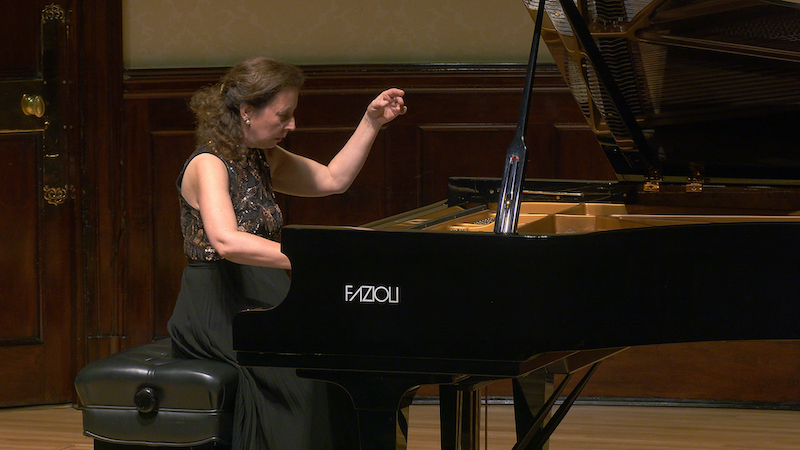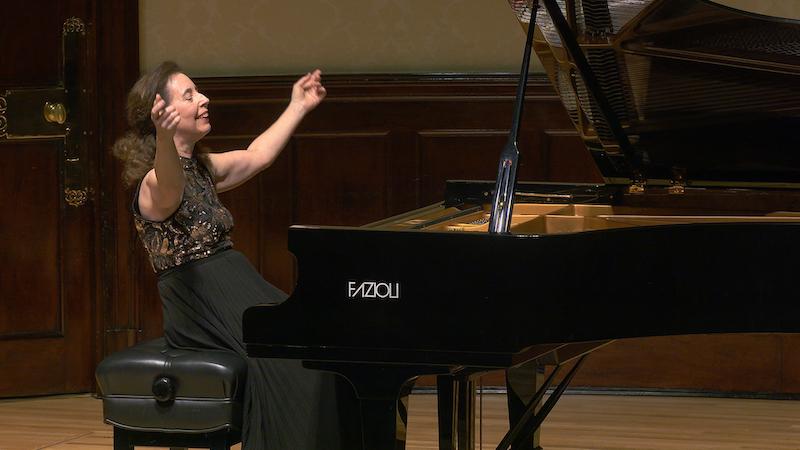If Angela Hewitt’s recital last night at the Wigmore Hall was a meal, it would have been two light, fresh – but nourishing – courses, followed by a big suetty pudding, splendidly cooked but sitting slightly heavy on the stomach. The delightful openers were a sequence of Scarlatti sonatas and a Bach partita, the afters a large portion of Brahms that, for me, sits in the “admire rather than love” category.
I do, though, love the Scarlatti sonatas, and one of the beauties of them is that you can be familiar with loads – but know there are always still more to discover. He wrote 555 of them, which is mind-boggling, and the variety is astonishing, given they mostly conform to the template of a five-minute one-movement binary form. Some of them are pretty technically accessible, allowing us limited pianists to have a bash. Kk322 is a good example: a simple two-part texture in trendy galant style that a grade 6 player could handle. But Angela Hewitt makes poetry from its unaffected simplicity, with a little feint here, a little ornament there, never over-egging the recipe.
Kk145 is tootling along in fairly conventional mode and then hits an astonishing harmonic twist in the cadence, which Hewitt brings off with a side-eye to the audience, making the unexpected harmony sound both wrong and yet right. Kk417 starts as a fugue, but somehow more elegant, wearing its learning more lightly than Bach does. Hewitt’s touch was forceful but never forced. Kk460 in particular makes me feel I’d have liked to have met Scarlatti – I think he must have been good company. And it is Hewitt’s achievement to make me feel like that, conjuring humour from the sparest of textures. Only in the last of the six sonatas, Kk466, did genuine, heartfelt emotion shine through, Hewitt’s singing right hand bringing out the saddest of laments. Bach’s Partita no.1 BWV825 offered more limpid textures, especially in the “Praeludium”. The “Allemande” danced like Bach should, coloured by dynamic variation, and the “Courante” had an unexpected grandeur. The melody of the “Sarabande” was elaborated with a sense of spontaneity which relaxed in the final “Gigue”, a veritable orgy of hand-crossing, a technique my grandmother always thought the pinnacle of pianistic skill.
Bach’s Partita no.1 BWV825 offered more limpid textures, especially in the “Praeludium”. The “Allemande” danced like Bach should, coloured by dynamic variation, and the “Courante” had an unexpected grandeur. The melody of the “Sarabande” was elaborated with a sense of spontaneity which relaxed in the final “Gigue”, a veritable orgy of hand-crossing, a technique my grandmother always thought the pinnacle of pianistic skill.
The second half was Brahms’s Third Piano Sonata, written when he was 20, before anyone had advised him that less is more (if anyone ever did tell him). It is funny to think that this is nominally the same form as the earlier Scarlatti, whose five-minute miniatures are now transmogrified into an epic five-movement, forty-minute monster, transparent textures replaced by fistfuls of notes, pounding chords and the long rhetorical paragraphs of Brahms in full flight.
Hewitt is of course equal to the technical demands, with power and projection in the big moments, and lightning-quick changes of mood. She articulated the musical architecture on the large scale – it all made sense – but I found her most at home in the inward moments of repose. These included the beautiful song-like second movement – but even there we are never far away from a highly-wrought climax. Of course, some of this is personal taste, and I am sure there were plenty in the packed house who preferred the intellectually weighty Brahms to the bon-bons of the first half. But for all that Hewitt revelled in the ferocious challenges of the last movement of the Brahms, for me she was heard to her best advantage in the playful simplicities and eccentricities of the Scarlatti.















Add comment